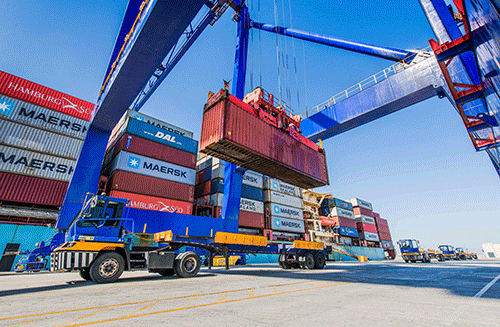The Namibian Ports Authority continues to realise its vision of becoming the best-performing port in Africa, as the parastatal, despite major challenges, reports year-on-year positive growth in its business dealings.
Namport, just like ports all over the world, also faced a global shortage of containers, disruption of the international logistics industry, and the Covid-19 pandemic.
However, during the past 12 months, the ports authority recorded substantial increases for both the Walvis Bay and Lüderitz ports.
Namport CEO Andrew Kanime says the total year-on-year cargo handled amounted to 6.5 million tonnes, indicating an increase of 380 541 tonnes.
The vessel visits also increased by 289 vessels, or 22%.
The increase in vessel calls was predominantly due to an increase in petroleum vessels, Namibian and foreign fishing vessels, foreign tugs and research vessels.
The Namibian Ports Authority also announced that TEUs handled amounted to 168 278, of which 61 106 TEUs or 36% were exported. A further 69 467 TEUs or 41% were imports, and 37 705 TEUs or 22% were transhipments.
Also, the TEUs increased by 12 298 or 8% year-on-year. This increase was mainly due to increased containerised commodities such as copper, charcoal, frozen fish, marble, frozen poultry, sugar, chemicals, scrap steel and wooden products.
The ports authority also indicated that bulk and breakbulk (BBB) volumes handled amounted to 4.4 million, of which, 1.8 million tonnes or 40% were exports, 2.6 million tonnes or 59% imported, and,709 tonnes or 1% were transhipped.
Overall, the BBB volumes increased year-on-year by 360 189 tonnes, or 9%. This increase was on the back of increased commodities such as petroleum, steel, frozen fish, ammonium nitrate, iron ore, marble, ship spares, manganese ore and flat cartons.
“The volume performance is certainly commendable, given the tough operating environment that characterised the financial year that it was,” Kanime said.
Cross-border volumes’ statistics also show that cross-border volumes increased by 10% from 1 464 000 gross tonnages during the 2020/2021 financial year to 1 606 984 gross tonnages during the 2021/2022 financial year.
At least 48% of the volumes are from South Africa, 23% from Zambia, 15% from the Democratic Republic of Congo, Zimbabwe and Botswana with 6% each, 2% from Angola, and 1% from Malawi.
According to the statistics, major commodities exported from SADC countries through Namibia are currently Copper, Manganese Ore and Wooden products (Timber).
Major commodities imported to Namibia destined for SADC countries are frozen poultry, vehicles, machinery, spare parts, tyres, chemicals for mining use, electrical goods and electrical equipment.
Namport at a glance
The Namibian Ports Authority is a public enterprise which was established by the Namibian Ports Authority Act, 1994 (Act 2 of 1994).
Namport has two ports. The port of Walvis Bay, situated on Africa’s southwestern coast, serves as a convenient and fast transit route, connecting southern Africa, Europe, Asia and the Americas.
The port of Lüderitz, located 254 nautical miles south of the Port of Walvis Bay, caters for Namibia’s southern regions, and provides access to South African markets in the Northern Cape.
The stable political environment in Namibia continues to attract foreign direct investment, while its ports form a natural gateway for international trade, strategically situated to offer direct access to principal shipping routes. Namibia’s connecting transport corridors enable the country to compete as a transport hub for all regional and international trade between the Southern African Development Community countries, Europe, Asia, the Americas and the rest of the world.
Namport is tasked to manage the port facilities to cater to current trade needs, develop the ports for future demands, as well as contribute to the competitiveness of the SADC region’s trade through the efficient, reliable and cost-effective supply of port services.
It should facilitate economic growth in Namibia by enabling regional development and cross-border trade, while also promoting the ports as preferred routes for seaborne trade between SADC, Europe, Asia and the Americas.
General vessel traffic is the heart of Namport’s business, and their two ports are visited by about 1 592 vessels and handle approximately 6.5 million tonnes of cargo per annum.
The Namibian ports also handle an assortment of cross-border cargo imports and exports via four (4) main trade corridors, being the Trans-Kalahari Corridor, Walvis Bay-Ndola-Lubumbashi Corridor, Trans-Cunene Corridor and the Trans-Oranje Corridor connecting the ports to the respective SADC markets, namely Zambia, DRC, Botswana, South Africa, Zimbabwe and Angola.


